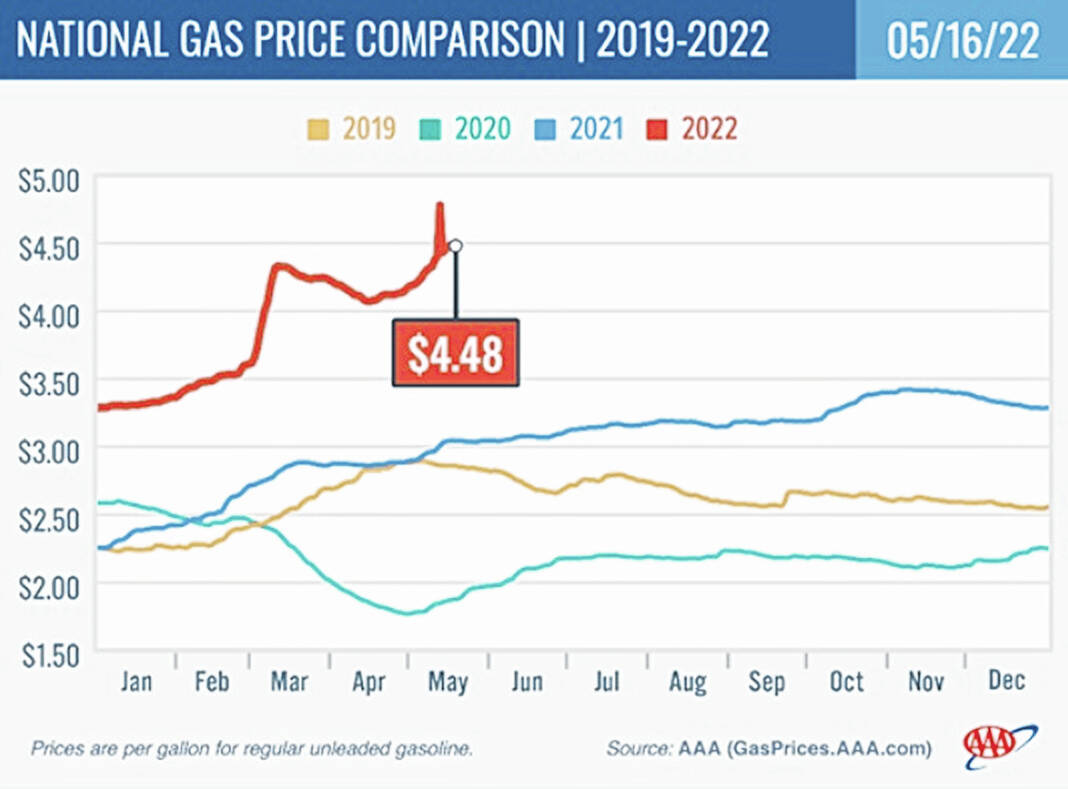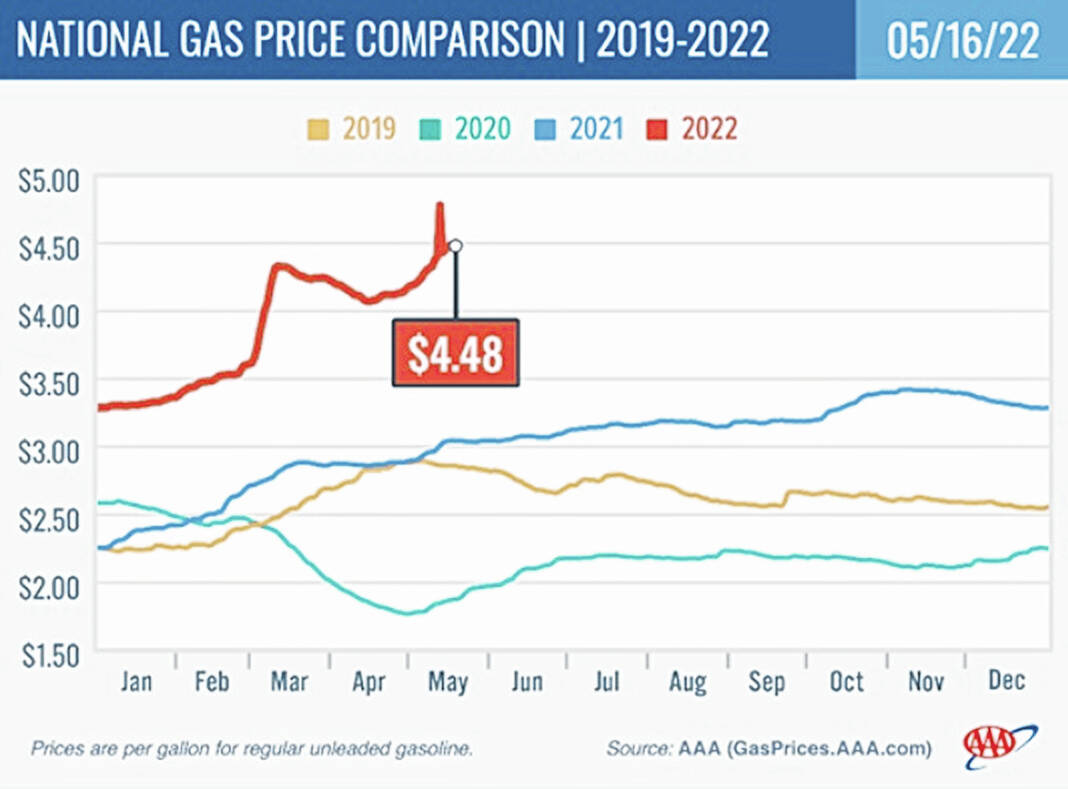

CINCINNATI — With the national average cost for regular gas steadily climbing, three states — Georgia, Kansas, and Oklahoma — are still holdouts for crossing the $4 per gallon mark.
The national average for a gallon of gasoline is now $4.48. The increase is primarily due to the high cost of crude oil, which is hovering near $110 a barrel.
“The high cost of oil, the key ingredient in gasoline, is driving these high pump prices for consumers,” said Andrew Gross, AAA spokesperson. “Even the annual seasonal demand dip for gasoline during the lull between spring break and Memorial Day, which would normally help lower prices, is having no effect this year.”
According to new data from the Energy Information Administration (EIA), total domestic gasoline stocks decreased by 3.6 million bbl to 225 million bbl last week. Gasoline demand also decreased slightly from 8.86 million b/d to 8.7 million b/d. Typically, lower demand would put downward pressure on pump prices.
However, crude prices remain volatile, and as they surge, pump prices follow suit. Pump prices will likely face upward pressure as oil prices stay above $105 per barrel.
Meanwhile, the switch to the more expensive summer blend of gasoline, which usually adds seven to ten cents per gallon depending on the market, is happening now. This switchover should be complete nationwide by early June.
This summer blend switch is an annual event. It is unrelated to the Biden Administration’s announcement a few weeks ago to allow the higher ethanol E15 gas blend to remain on sale throughout the summer until September.
“The expected bump in gas prices is now taking leaps,” said Kara Hitchens, public affairs manager. “We encourage drivers to take these cost-saving measures seriously and combine them as they can help save money.”
Market dynamics
At the close of Friday’s formal trading session, WTI increased by $4.36 to settle at $110.49/bbl.
At the beginning of last week, the price of crude oil decreased due to global market concern that crude demand will suffer as COVID lockdowns in China remain in place.
However, crude prices reversed course at the end of the week over growing market worries that Ukrainian and European Union actions against Russian oil and natural gas companies could spark retaliation by Russia, which would lead to more market disruption and uncertainty.
Crude prices could fall this week if demand concerns continue to weigh the market down. Additionally, EIA reported that domestic crude supply increased by 8.5 million bbl to 424.2 million bbl. The current level is approximately 12.5 percent lower than during the first week of May 2021.
Drivers can find current gas prices along their route with the free AAA Mobile app for iPhone, iPad, and Android. The app can also map a route, find discounts, book a hotel, and access AAA roadside assistance. Learn more at AAA.com/mobile.
AAA gas-saving tips
Get your vehicle checked out. Perform regular car maintenance at the intervals recommended by the vehicle manufacturer in the owner’s manual or as indicated by the in-car maintenance reminder system. Did you delay regular maintenance during the pandemic because you were driving less? Now is the time to get it looked at. Find a AAA Approved Auto Repair Facility here.
Keep tires properly inflated. Under-inflated tires can decrease your gas mileage by approximately 3 percent. Not to mention, properly inflated tires are safer and last longer. Check pressure in all four tires every two weeks with an accurate, hand-held air pressure gauge.
Know your octane. Do not purchase mid-grade or premium gas unless your owner’s manual specifically recommends it. According to AAA research, Americans waste more than $2.1 billion annually on premium gas in vehicles designed to run on regular fuel. AAA found no benefit to using premium gas instead of regular-grade fuel. At the time of the study, 70% of U.S. drivers owned a vehicle that required only regular gasoline.
Avoid idling. Idling gets zero miles per gallon. Letting your vehicle idle for more than 10 seconds uses more gas than shutting it off and restarting. Don’t start your car until you are ready to go. The engine actually warms up more quickly once the car is operating, and will stay warm after stopping. Avoid drive-up windows – park and go inside instead.
Observe the speed limit. Gas mileage decreases rapidly at speeds above 60 mph. Each 5 mph you drive over 60 mph is like paying an additional $0.15 per gallon of gas. Using cruise control on the highway helps you maintain a constant speed and, in most cases, will save gas.
Drive sensibly. Aggressive driving (speeding, rapid acceleration and braking) wastes gas. It can lower your gas mileage by 33 percent at highway speeds and by 5 percent around town.
Consolidate trips. Combining errands into one trip saves you time and money. Several short trips taken from a cold start can use twice as much fuel as a longer multi-purpose trip covering the same distance when the engine is warm. With a little planning, you can avoid retracing your route and reduce the distance you travel as well. You’ll not only save fuel, but also reduce wear and tear on your car.
Minimize drag. Drag reduces fuel efficiency. Driving with the windows open, using roof- or rear-mounted racks and carrying heavy loads increase vehicle drag. A roof rack or carrier provides additional cargo space and may allow you to meet your needs in a smaller, more fuel efficient car. However, a loaded roof rack can decrease your fuel economy by 5 percent. Reduce aerodynamic drag and improve your fuel economy by using a removable rack and placing items inside the trunk whenever possible. Avoid carrying unnecessary items, especially heavy ones. An extra 100 pounds in the trunk reduces a typical car’s fuel economy by 1-2 percent.
Use loyalty and membership programs to save. Many gas stations, grocery store and warehouse store offer savings on gasoline to their members.
For those in the market for a new fuel-efficient ride in 2022, the latest online AAA Car Guide is now available. All category winners are electric or electric hybrid vehicles. The AAA Car Guide also contains detailed information about AAA’s recent research on current automotive technologies and topics, such as driver assistance systems, gasoline quality, headlight effectiveness, etc.


